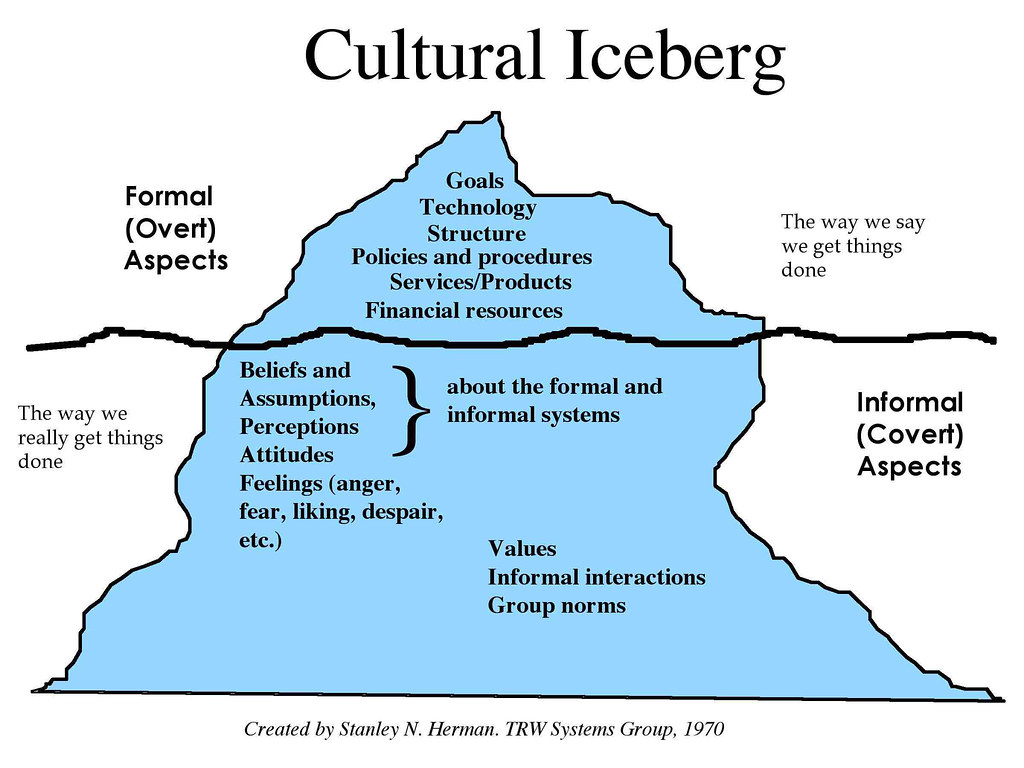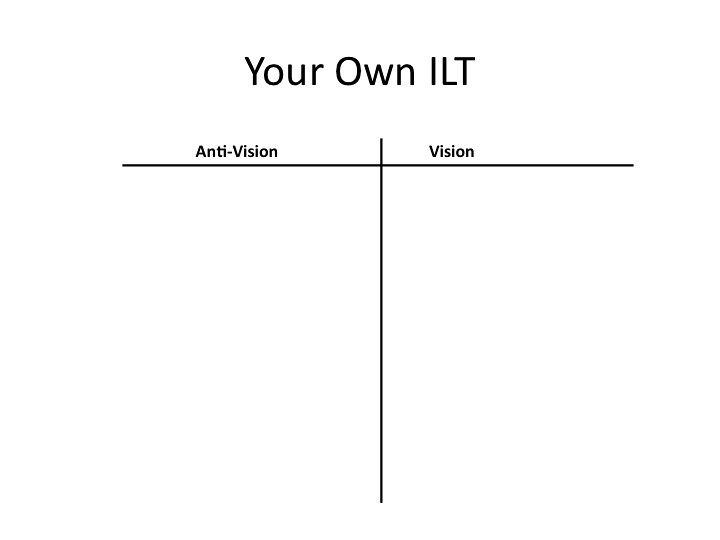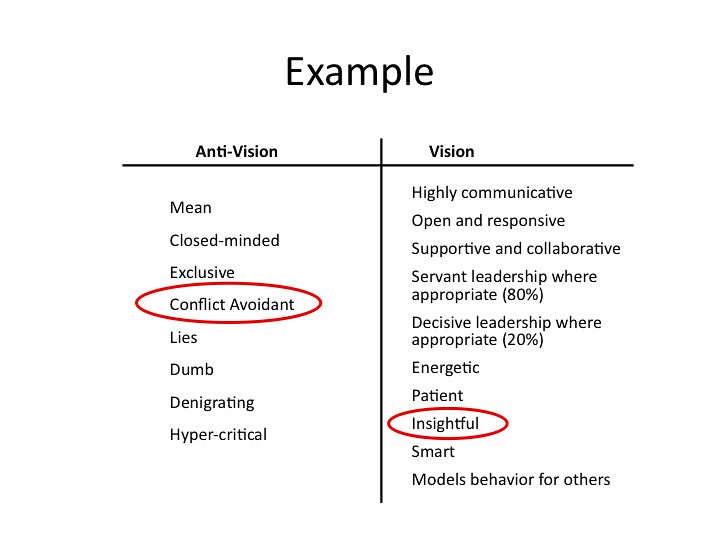Hack:
The Incongruency Principle: Coupling Self and Systems Knowledge

Wendell L Franch and Cecil H. Bell, Jr, Organisation Development: Behavioral Science Interventions for Organisational Improvement, 2nd Ed., © 1978
This is a familiar image from the past. But how well have we tackled it here at the MIX on the way to re-visioning management? As we continue to develop our stories and hacks that revolutiionize our systems and designs, including those for problem-solving, engagement, power, and pay, we may have left out the one most important aspect of an innovative approach -- which is understanding and managing human incongruency. Every system, every person has blind spots, and this is nowhere more destructive to creativity, adaptation and resilience than in the incongruency of leadership behavior. Here are a few examples from my own experience:
- The CEO who says he would like "to open up communications in the management team" but becomes angry and abruptly ends the effort when members of his senior team suggest that his own behavior (blowing up at managers publicly) is part of the reason people don't speak up.
- The senior VP of a research organization that says she wants to encourage more cross-disciplinary collaborations, but does not engage people in a discussion of this topic because she does not see herself as "very good with this people stuff."
- The manager who wants to guide a team that in her words, "feels more like a community of practice than a work unit" but who becomes so emotional about human relationships that she drives people away from her own vision.
- The IT Vice President who wants his department's management team to operate as a self-leading group and believes so thoroughly that the end of the day "the best idea will win through debate" that members' conflicting ideologies (including his own) that block all decisions in the group. As a result the reputation of the department suffers and eventually, because of the team's inaction on critical organizational imperatives, he is replaced.
- Incongruence is a source of break-through learning in blind spot areas -- by definition hard to learn from because they threaten personal identity and/or organizational brand and reputation.
- Incongruence is not something a person or an organization can ever fully "overcome." There will always be some level of incongruence as new layers of understanding reveal themselves and new challenges emerge.
- Incongruence exists on a personal level that is connected to the organization and vice versa -- the problem is not "out there" with others; it is "in here" with self and organization together.
Core Questions
- A leader or leadership group asks for information about personal and organizational incongruence directly.
- This is initiated and continued voluntarily over a long period of time.
- The leader or leaders specifically search out the coupling of individual and organization behaviors.
- People help each other get past their defensiveness rather than exacerbate it.
- As a community, people help each other grow and mature in what they are learning about themselves and their enterprise community.
Stress
- Interpersonal: Reduce stress by talking with others about incongruences you've discovered. What do they make of them? What can they add in terms of interpretation and reassurance?
- Physical/Kinesthetic: Run, golf, bike, weight lift, dance your way out of the stress that comes from gaining disconfirming data.
- Linguistic: Write free-form in a journal about what you are learning. Write a story about it and then check your story for insights that challenge an older way of being. Read books about leadership growth and learning, such as Peter Koestenbaum's seminal Leadership: the inner side of greatness.
- Logical/Analytical: Look for the direct benefits of gaining data that doesn't just reinforce earlier self-concepts and protect yourself from the truth. Remind yourself of the value of busting personal, not just organizational paradigms. Learn to see perceptual data (how people feel or see things) as meaningful clues to deeper, more fundamental forms of psychological and social knowledge.
- Visual/Spatial: Use artistic or architectural forms to depict core incongruencies, such as fractured images and buildings that will topple. Then interpret these forms by asking, "What have I actually drawn?" "What does this mean to me?" "To our organization?"
- Intrapersonal: Meditate to relieve the stress of information about which you might otherwise feel emotional. And also meditate on the incongruent data. Sit with it, cultivating both detachment and learning.
- Naturalistic: Walk in the natural world to regain your sense of equilibrium. Consider the source of incongruence nature itself. Where do you find disruption true in nature -- a flood, a fire, an earthquake -- what is the process and result?
- Musical: Spend time singing, writing, or listening to music in order to relax. What emotions does the incongruity provoke? How can that be represented in musical form? How do "these notes" resolve?





Thanks for your thoughtful post Dan – as you suggest new ways of going at leadership – you’d likely release a diverse mix of leaders – and also open new job opportunities the nation craves!
I’d like to respond through Mita’s tested and proven 5 Brainpowered Lenses, since that’s the way I guide liberating consciousness journeys– through researched Mita windows, which your reflection
inspired me to revisit here:
• Question possibilities, and ask: How can I encourage leaders to extend leadership, trust and community to include each person’s offering as well as life-changing discoveries about the human brain?
• Target improvements by viewing growth through each one’s perspective – and support trust between us by enhancing the best in each as well as proposing alternatives for parts that work less well.
• Expect quality differences so that people at the MIX become capital and knowledge gets shared in ways that add excellence to the entire community.
• Move multiple intelligences into genuine action tools for evidence based team solutions – after I’ve questioned my own involvement and set reachable targets for myself that can be both measured and tracked fairly.
• Reflect on growth possibilities by considering: What if we designed a way together to host a celebration of innovation that engaged the wider community, focused on building trust, and opened our approaches to a very different kind of leadership that valued more than rated ideas based on conventional assessments.
Then I can see more clearly the need for the robust dialogue you detailed here, and for the facilitation skills needed to sustain it to its endpoints in an engaged, talented and highly innovation circle of leaders pulling together!
You have opened some delightful questions here that fuel Mita 5-step leadership renewal work daily – Dan – thanks! Mita Brainpowered tools are chiefly concerned with doable applications in the form of mind-bending action steps – built from diverse leaders with human brains in mind. The tools are then applied in ways that gain proven higher motivation and achievement for an entire group. I will be interested to see how others suggest turning consciousness into doable and innovative action steps.
Thanks to you and many MIX leaders for refreshing triggers that could help us design innovations that shape workplaces into the communities we want others to see in us.
- Log in to post comments
- Log in to post comments
Agree Dan and thanks, the "dialogue" is often what moves team innovation forward. Used the Mita approach to try and see what is your main question here? Hoped I'd spark you to help me understand a bit more of your suggested direction:-).
What one core question are you asking. What clear target do you suggest? Can you list a few bullet expectations?And how (in one core trigger statement) would you suggest it rolls out:-)?
That's why I used the Mita leadership approach to try and see your proposal with clearer vision. Thoughts?
- Log in to post comments
- Log in to post comments
Dan, I like how you framed this discussion -- lots of good stuff in here to apply!
This is the crux of the matter:
"It is a matter of attachment to particular ideas and a particular sense of self -- something not confined to any particular type of organization. As long as there are owners, people who have power over structure and communication, the problem of incongruency potentially pertains."
As I read this, I am reminded of how much my own attachments to ideas and a particular sense of self are with me in every walk of my life. A healthy, sobering reminder.
This line is great: "There is no external, organizational program universally smarter than the defensive strengths of individuals."
So very true!!
I think there are some types of training programs -- such as mindfulness training -- that, when run properly, and without any expectations or strings attached, can help people to recognize the incongruency principle at work in themselves.
For example, Google has an employee education program called "Search Inside Yourself" that teaches mindfulness meditation and the neuroscience of emotional intelligence:
http://www.contemplativemind.org/resources/SUN_Sept09_Google.pdf
Increasing self-awareness gives us more mental space to work with. As a result, we can be more mentally and emotionally present when listening to feedback from others that conflicts with our self image. We can then make
more conscious choices on how to respond to that information, instead of jumping to an instinctive fight-or-flight response -- and possibly even use it for alchemical transformation in ourselves,
Of course, you can lead a horse to water, but you can't make it drink. Offering courses to people in no way guarantees that they will do the necessary internal work. As you say, "*I* must choose to take on the challenge for *me*". Leaders must live and embody the culture that they want to see in their organization.
Great reminder of the kind of growth that is within the reach of any of us, doesn't cost one cent, and has a transformative impact on ourselves, our organizations, and the world.
- Log in to post comments
- Log in to post comments
Dan, I love the awareness you bring to this important issue - and opportunity. My impression is that we've done well at the top of the iceberg. Now, the real opportunity for progress lies beneath the surface, in our self-awareness and congruency, as you say. This is much harder work, but may be the true purpose of organizations. I heard Jeffrey Hollender, former CEO of Seventh Generation, give a talk a year or two ago at a conference on Corporate Social Responsibility. He said that the primary purpose of organizations is to grow the consciousness of the people within. This goal becomes even more compelling as we see that growing the consciousness of the people within is also what's needed to grow the business. Articles like yours help nudge us in that direction. Thanks!
- Log in to post comments
- Log in to post comments
Interesting effort to codify a very complex subject. As a psychiatrist and consultant/coach who has worked with many executives and professionals of all kinds over the years, my concern with your approach is that you are focusing on only one defense mechanism. By doing so you will miss the many other equally unconscious and powerful defenses that get in the way of leader's relationships and effectiveness in the work world. In addition, there are so many crucial psychological issues that contribute even to the defense of defensiveness. Ego-fragility, narcisism, perfectionism, anxiety, unresolved anger, inability to know or articulate internal states and emotions. The list goes on.
I commend your attempt but I feel your approach is too narrow. The question is more about how do you address complex psychological processes that interfere with good leadership within the work environment. Many coaches and coaching companies have moved away from addressing "derailing" behaviors for the very reason that most coaches do not have the knowledge or experience to address them or, even when they do, it is very challenging to do within the work environment.
I understand that you are trying to bring about positive change by at least addressing one common problem found in often egocentric and difficult leaders. And I do believe that you have created a good, non-threatening approach to get such leaders to be more self-reflective and tolerate the uncomfortable emotions and internal state that arise from being given negative feedback. I just caution that systemizing this type of work, especially when addressing just one defense, can often backfire as the underlying issues and other defenses that are not understood or addressed can lead to very superficial change at best and worsening behavior in other ways at worst.
I do agree with the need and I applaud your attempt to address this type of issue.
- Log in to post comments
- Log in to post comments





You need to register in order to submit a comment.